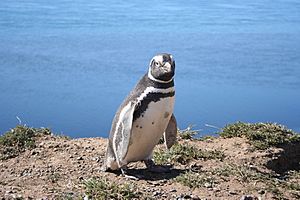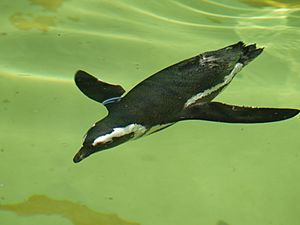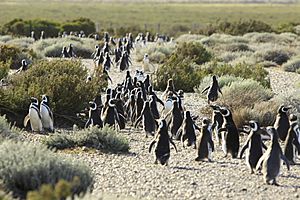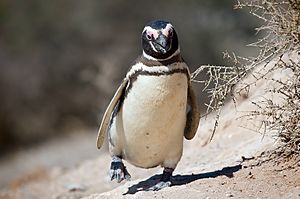Magellanic penguin facts for kids
Quick facts for kids Magellanic Penguin |
|
|---|---|
 |
|
| Conservation status | |
| Scientific classification | |
| Kingdom: | |
| Class: | |
| Order: | |
| Family: | |
| Genus: |
Spheniscus
|
| Binomial name | |
| Spheniscus magellanicus (Forster, 1781)
|
|
 |
|
| Red area shows range | |
The Magellanic penguin (scientific name: Spheniscus magellanicus) is a very common type of penguin. There are about 3.6 million of these penguins in the world. They are named after Ferdinand Magellan, who first saw them in 1519 during a trip to South America.
These penguins are about 70 cm (27.5 inches) tall and weigh around 4 kilograms (9 pounds). They live in places like the Falkland Islands, South America, Chile, and Argentina. Some even travel to Brazil during their migrations. Magellanic penguins are warm-weather birds. They lose feathers around their eyes when it's warm and grow them back when it gets colder. Young penguins learn to hunt for food on their own when they are about 60 to 70 days old.
Contents
What do Magellanic Penguins Look Like?

Magellanic penguins are medium-sized. They grow to be about 61 to 76 cm (24 to 30 inches) tall. They can weigh between 2.7 and 6.5 kg (6 to 14 pounds). Male penguins are usually bigger than females. Both parents lose weight while they are raising their young.
Adult penguins have black backs and white bellies. They have two black bands across their chest. The lower band looks like an upside-down horseshoe. Their heads are black with a wide white stripe. This stripe goes from behind the eye, around the ear, and joins at the throat. Baby penguins and younger ones have grey-blue backs. Their chests are a lighter grey-blue color. Magellanic penguins can live for up to 25 years in the wild. In zoos, they can live even longer, sometimes up to 30 years.
Young birds often have spotted feet. These spots fade as they get older. By the time they are about ten years old, their feet usually turn completely black. Like other penguins, Magellanic penguins have stiff, strong wings. They use these wings to swim very well underwater.
What do Magellanic Penguins Eat?
Magellanic penguins find their food in the water. They mostly eat cuttlefish, squid, and tiny shrimp-like creatures called krill. They also eat other small crustaceans. When they eat, they also swallow seawater. But don't worry, they have a special gland above their eyes. This gland helps them get rid of the extra salt from their bodies.
Adult penguins can dive deep to find food. They often go down 20 to 50 meters (65 to 164 feet) underwater. During the time they are raising their chicks, both male and female penguins hunt in similar ways. They also eat the same kinds of food. However, after the breeding season, their diets might change. This happens when they no longer need to feed their chicks.
Magellanic penguins usually have enough food. This is because they live along the Atlantic coast of South America. This area has a large underwater shelf. This shelf allows the penguins to find food far from their nesting places. Scientists have even found that these penguins actively hunt for jellyfish. They used to think penguins only ate jellyfish by accident.
Magellanic Penguin Reproduction and Life Cycle
Magellanic penguins travel in large groups when they hunt for food. During the breeding season, they gather in big nesting areas. These areas are found along the coasts of Argentina, southern Chile, and the Falkland Islands. There can be as many as 20 nests in a small area of 100 square meters.
The breeding season starts in September when adult penguins arrive at the colonies. It lasts until late February or March. By then, the chicks are old enough to leave. One of the biggest nesting places is at Punta Tombo. Penguins build their nests under bushes or in burrows (holes in the ground).
Female penguins lay two eggs. Both parents take turns sitting on the eggs to keep them warm. This is called incubation. It lasts for 39 to 42 days. Each parent takes shifts of 10 to 15 days. After the chicks hatch, both parents care for them for about 29 days. They feed the chicks every two to three days. Usually, both chicks grow up successfully. Sometimes, only one chick survives. On average, a successful pair of Magellanic penguins raises about 0.7 chicks each breeding season.
Magellanic penguins lay their eggs in warm places. The temperature usually stays above 20℃ (68℉). The male and female penguins take turns incubating because they have to travel far to find food. The male returns from the sea on the day the second egg is laid to start his turn. The second egg is often larger and warmer than the first. The first chick is usually more likely to survive. However, sometimes both chicks can be raised successfully.
Magellanic penguins often mate with the same partner every year. The male penguin returns to his burrow from the previous year. He then waits for his female partner to join him. Female penguins can recognize their mates just by their calls.
Challenges for Magellanic Penguins

Millions of Magellanic penguins still live along the coasts of Argentina and Chile. However, they are considered a threatened species. One of the biggest dangers is oil spills. These spills kill many adult and young penguins each year off the coast of Argentina. Zoos around the world sometimes adopt young penguins to help raise them and protect the species.
Another problem is that the fish they eat are becoming harder to find. Predators also hunt penguins. These include sea lions, large seabirds called giant petrels, and leopard seals. These animals often prey on young penguin chicks. In the past, a type of fox called the warrah also hunted penguins, but this animal is now extinct.
Climate change is also affecting Magellanic penguins. The fish they eat have moved to different areas. This means penguins have to swim much farther, sometimes an extra 40 kilometers (25 miles), from their nests to find food. While one parent is out hunting, the other parent is waiting on the nest and might go hungry.
A study by Professor P. Dee Boersma showed that a penguin colony near Buenos Aires has shrunk by over 20% in 22 years. This leaves about 200,000 breeding pairs. Some younger penguins are moving their nesting sites north to be closer to fish. But sometimes these new areas are on private land and not protected. Because of these changes, some penguins get lost or confused.
Currently, 12 out of 17 penguin species are facing fast population declines. Professor Boersma's study also found that more rainstorms, caused by climate change, are harming penguin chicks. Young chicks haven't grown their waterproof feathers yet. So, they are more likely to die from hypothermia (getting too cold) during big storms. More extreme weather events like storms, droughts, and very hot or cold temperatures also make it harder for Magellanic penguins to successfully raise their young.
Protecting Magellanic Penguins
The government of Chubut Province in Argentina is working to create a special protected area. This area is called a Marine Protected Area (MPA). It will help protect the penguins and other sea animals near the largest Magellanic penguin breeding colony. Creating an MPA would likely help the penguins raise more chicks successfully. It would also mean more food is available closer to their nests. This would reduce how far they have to swim to find food and allow them to feed their chicks more often.
Images for kids
See also
 In Spanish: Pingüino de Magallanes para niños
In Spanish: Pingüino de Magallanes para niños





